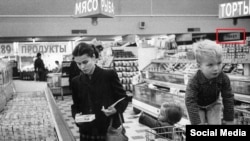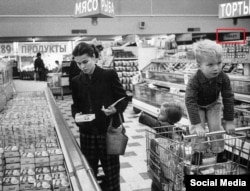Recently, a photo has been circulating throughout Russian-language Facebook, Twitter, and other social media.
It is purported to be a photo of a Soviet supermarket from the 1960s or 1970s. The shelves and freezer displays are fully stocked, suggesting the author was trying to refute the well-known stereotype about Soviet stores with lines of customers and empty shelves.
In fact, the photo is a fake. Russian and Ukrainian social media users quickly spotted two key flaws in the photo. The font used on the hanging signs which read “meat,” “fish,” and “cakes” is Arial narrow, which did not exist in the 1960s. But there’s an even more obvious clue anyone can spot: in the background is a mirrored sign reading “CANDY,” in English.
The photo actually depicts an American supermarket. One version of the real photo is marked as belonging to Getty Images. It was also used on the cover of a book called Promises to Keep: The United States Since World War II by Paul S. Boyer.
Fake or misleading photos are often a staple of modern Russian propaganda. More often than not, they are quickly debunked by Russian social media users before anyone else. While they are sometimes spread by obscure blogs or media outlets, they can also be used by major state-run media networks.
Last year, Polygraph.info reported that the state-run news agency TASS had circulated photo “evidence” confirming the death of Islamic State leader Abu Baqr al-Baghdadi.
A more egregious example was aired on a program on one of Russia’s largest state-owned TV networks, Channel One, in November of 2014. The satellite photo supposedly depicted a “Ukrainian Air Force” fighter plane shooting down the Malaysian Airlines flight MH17, which occurred in July of that year. The photo was shown to be a poorly-done alteration in a computer program like Adobe Photoshop. It was debunked almost immediately after Channel One aired it.







